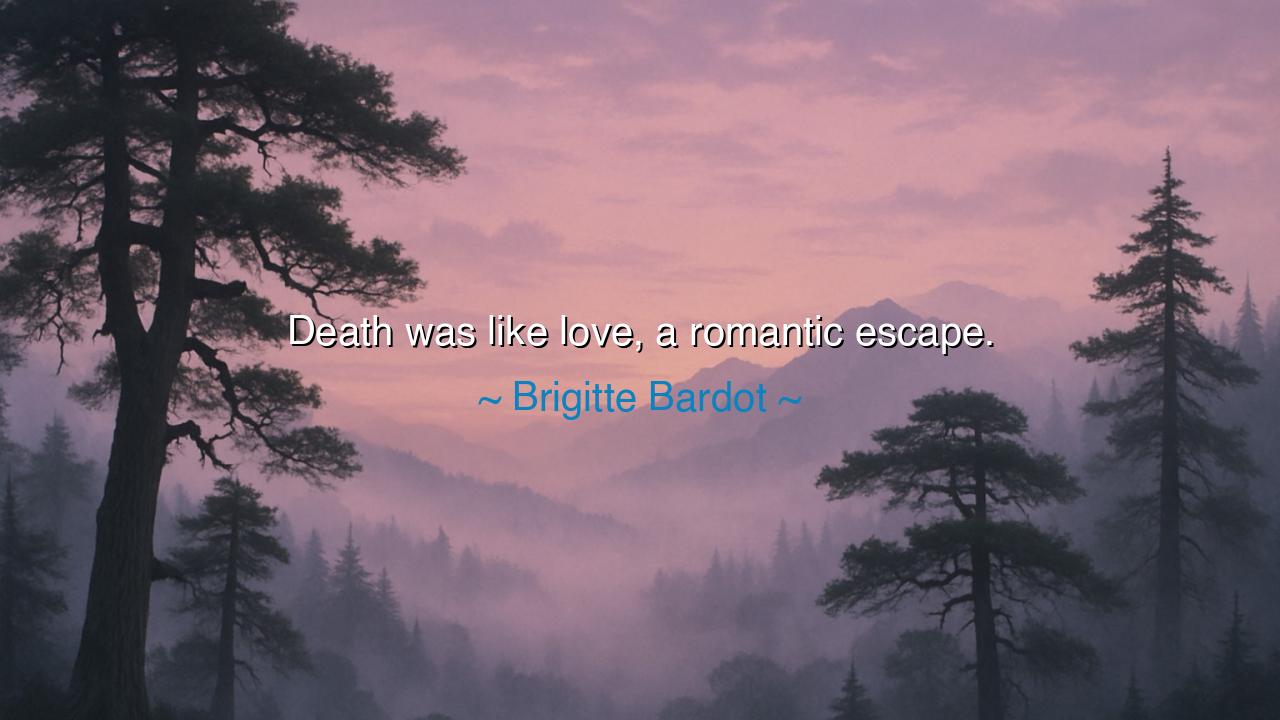
Death was like love, a romantic escape.






"Death was like love, a romantic escape." – Brigitte Bardot. In these words, Bardot touches on a deeply philosophical and emotional perspective, one that explores the parallel between death and love as escapes from the suffering and limitations of life. For Bardot, both death and love offer a kind of release—death as the ultimate escape from the trials of existence, and love as an emotional escape that transports us beyond the confines of the self. In the ancient world, death and love were often viewed as forces that could transcend the boundaries of the earthly realm and lead the soul to a different kind of freedom—whether through the finality of death or the elevating power of love.
In the Greek tradition, death was often portrayed not as an end, but as a transition. The Underworld, ruled by Hades, was not merely a place of punishment but a place of rest. Orpheus, the great poet and musician, journeyed to the Underworld in a desperate attempt to retrieve his beloved Eurydice, driven by the power of love to transcend even the finality of death. Yet, he too came to understand that love, like death, could not always offer permanence. His tragic failure to bring Eurydice back is a reminder that while love can elevate, it cannot entirely escape the mortal constraints of time and loss. In a sense, Orpheus’s journey to the Underworld represents the very tension between escape and reality that Bardot speaks of—love and death are both forces that promise release, but ultimately, they are bound to the limits of human existence.
Similarly, Plato in his dialogues, especially in the Phaedo, presents death not as an end but as the liberation of the soul from the body. In his vision, death was not something to be feared, but an opportunity for the soul to return to the divine, to experience eternal truth and beauty. For Plato, love too was a means of transcending the physical world and reaching higher understanding. Eros, the god of love, was the one who could lead the soul to higher wisdom and harmony. Both death and love were seen as pathways—one leading toward spiritual liberation, the other offering a journey toward divine union. Bardot’s analogy between death and love speaks to this universal longing for freedom from the mundane and for union with something greater, whether it is the infinite peace of death or the transcendent passion of love.
The poet John Keats, in his famous poem Ode to a Nightingale, also speaks of death and love as twin forms of escape. He writes of longing to transcend the world of suffering and decay, to be carried away by the sweetness of the nightingale's song, a song that represents both love and death. In the poem, Keats imagines death not as something fearful, but as a peaceful release—a romantic escape from the limitations of life. His contemplation of death is intertwined with a deep appreciation for the beauty and love that exist in the world, suggesting that both death and love offer profound ways to escape the burdens of the physical world. For Keats, as for Bardot, death is not a tragic end, but a romantic transition to something beyond the confines of earthly existence.
Bardot’s view also reflects the existential tension that has plagued humankind for millennia: the desire to escape the pain and suffering inherent in life, and the search for meaning through love and death. Victor Hugo, in his epic Les Misérables, portrays Jean Valjean, a man deeply affected by the suffering of the world, who finds a kind of redemption and escape through love and sacrifice, even as he faces the shadow of death. His journey is one that mirrors Bardot’s reflection—love as an escape from suffering, and death as a final release from the trials of existence. The idea that love and death are intertwined as forms of escape allows us to see both forces as natural responses to the human condition, seeking liberation from the confines of time, pain, and loss.
The lesson we take from Bardot’s words is that both death and love are powerful, transformative forces, each offering a form of escape from the limitations of the self and the world. They are deeply tied to our desire for freedom, whether that freedom comes through the release of death or the elevation of love. In life, we seek love not only for its own pleasures but because it offers a chance to transcend our individual limitations. Similarly, death, while feared by many, also represents the possibility of peace, a final escape from life’s burdens. Both are inevitable in the human experience, yet both offer ways to explore the depth of meaning in existence.
In our own lives, we must learn to navigate the tension between escaping and living fully. While death may one day offer the release we seek, in the meantime, it is love that provides the meaning and purpose we crave. We must not wait passively for the romantic escape of death, but actively seek to live fully and embrace the transformative power of love. Whether in our relationships, our pursuits, or our inner journeys, we must allow love to lift us, to carry us beyond the boundaries of the self, and to remind us that, in the end, it is connection, not escape, that gives life its deepest meaning.






AAdministratorAdministrator
Welcome, honored guests. Please leave a comment, we will respond soon